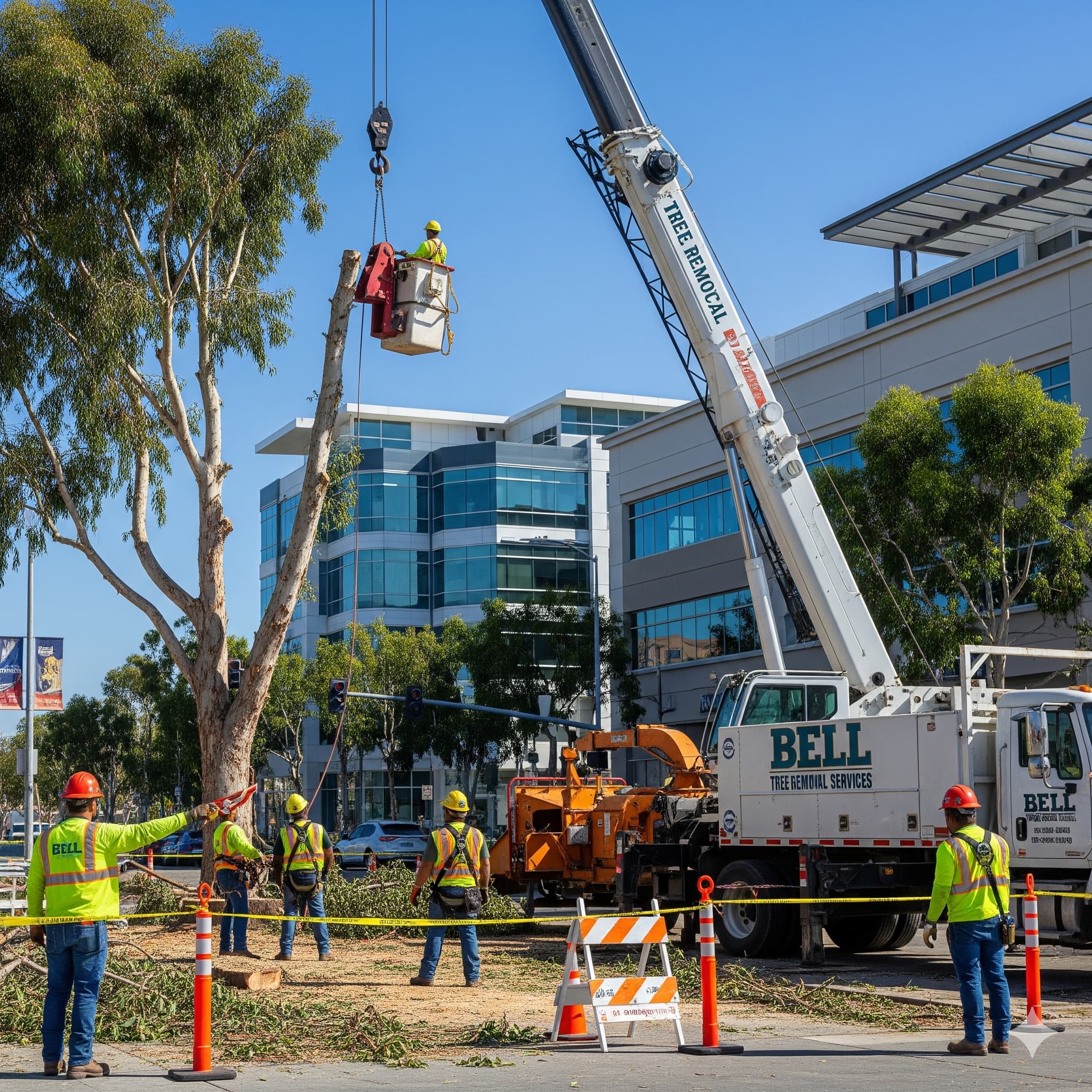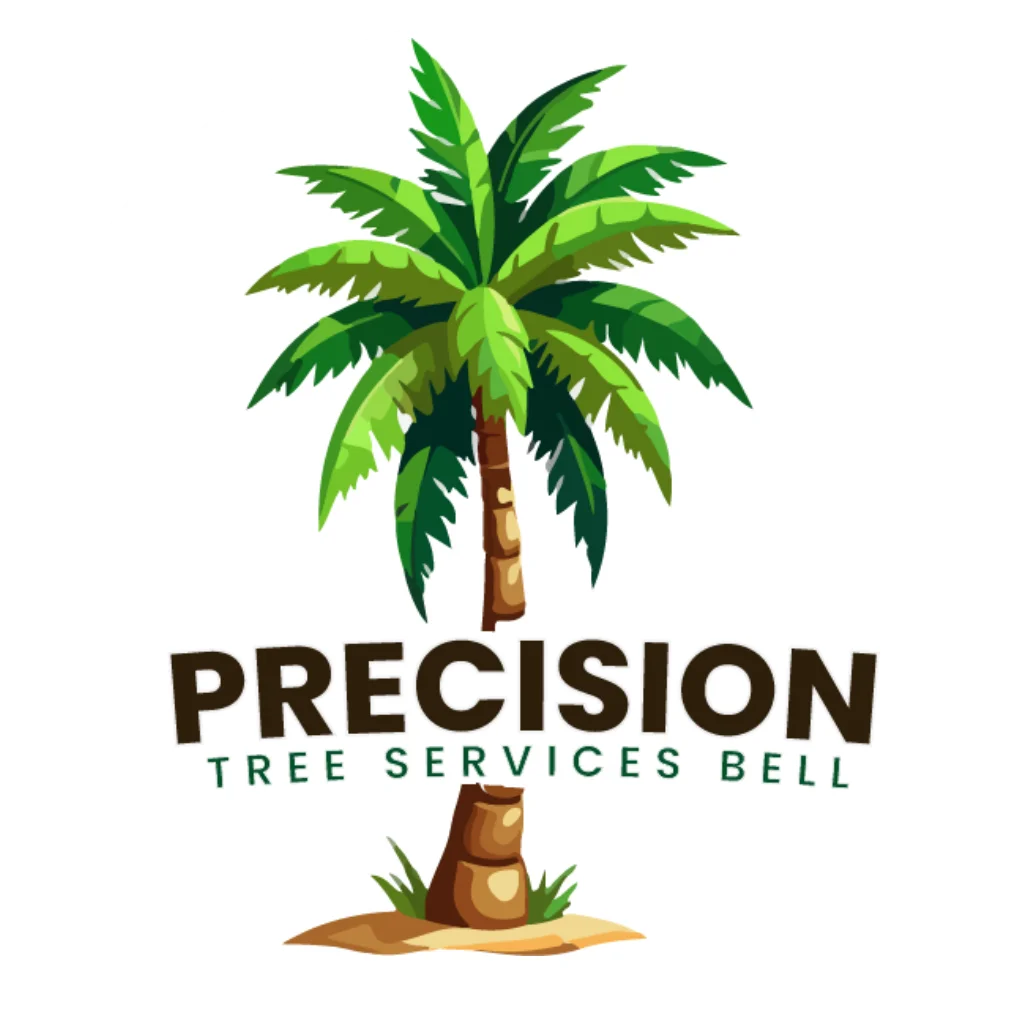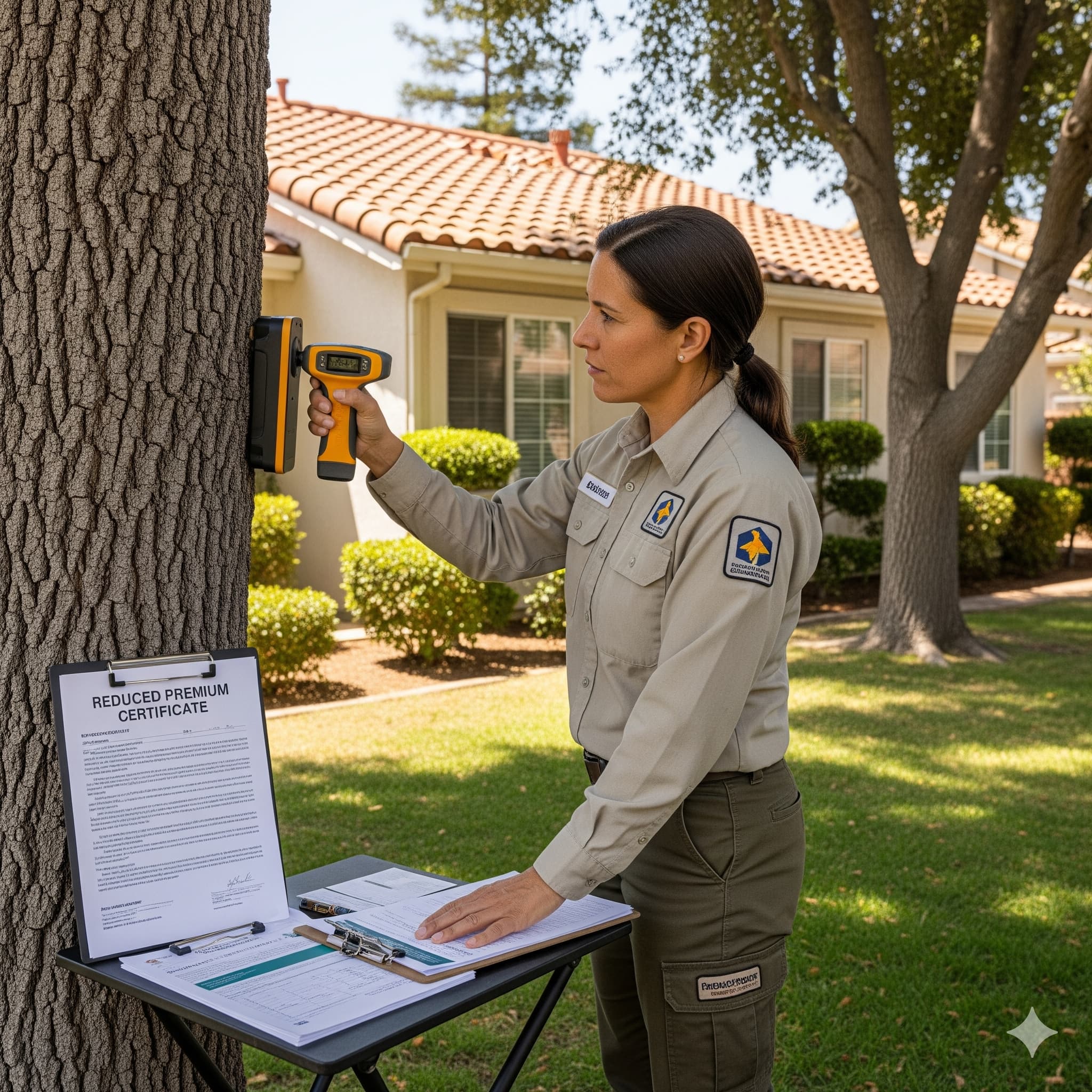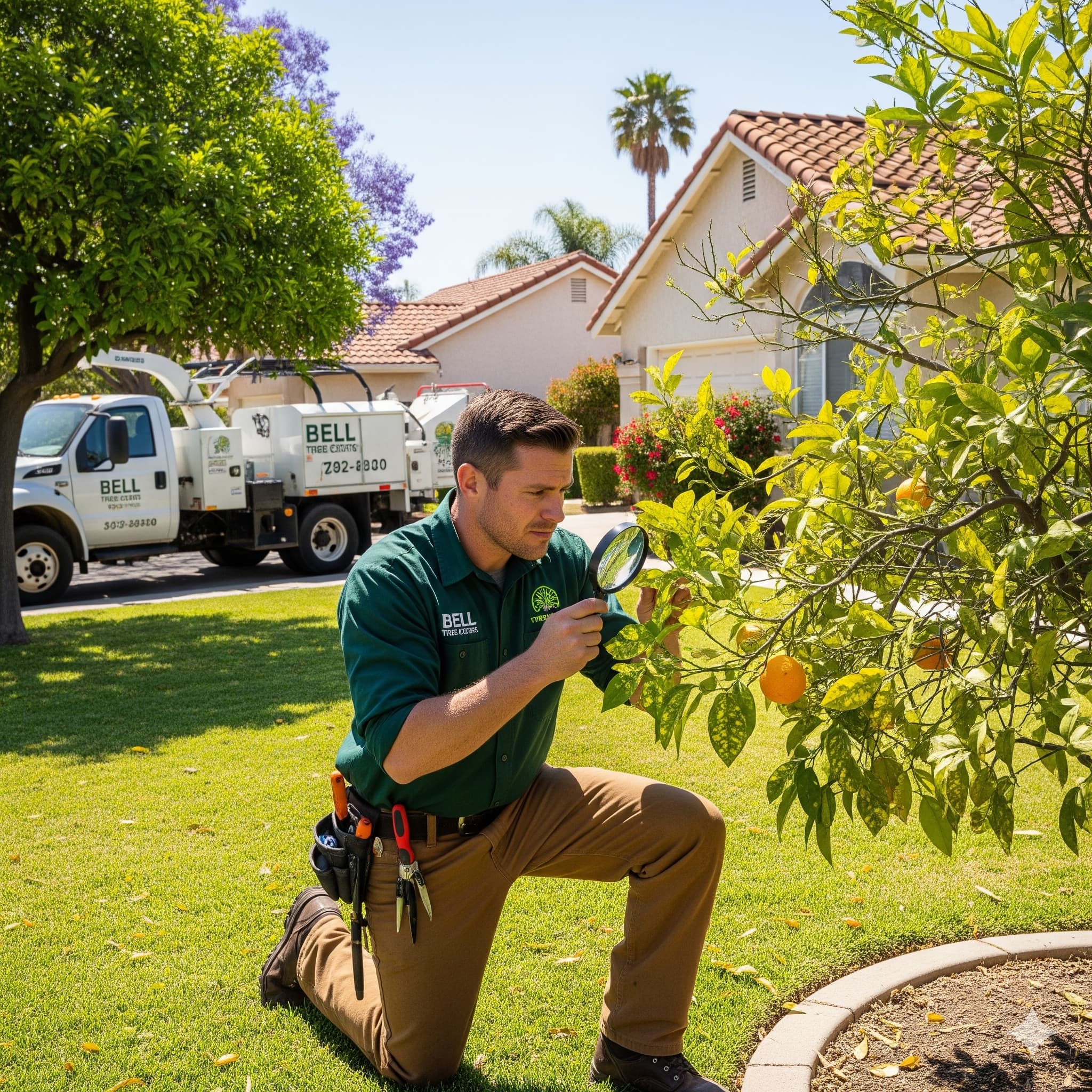
Effective Tree Disease Treatments in Bell
Tree Disease Treatment Bell
Maintaining healthy trees in Bell, California requires understanding the unique disease challenges facing urban landscapes in Southern California. From citrus greening threatening beloved backyard orange trees to sudden oak death affecting native species, effective tree disease treatment has become essential for preserving Bell’s urban forest. Professional disease management protects property values while ensuring the community’s trees continue providing environmental benefits for future generations.

Common Tree Diseases Affecting Bell Properties
Citrus Greening Disease (Huanglongbing)
Bell residents with citrus trees face a serious threat from Huanglongbing (HLB), also known as citrus greening disease. This bacterial infection has been detected throughout Los Angeles County, including nearby communities, and poses a fatal threat to citrus trees with no known cure. The disease is spread by the Asian citrus psyllid as it feeds on citrus tree leaves.
Infected citrus trees produce fruit that is poorly colored, possibly lopsided, and bitter-tasting. Leaves show asymmetrical, blotchy mottling, and trees may exhibit twig dieback and premature fruit drop. Early detection and immediate reporting to agricultural officials are crucial for community-wide disease management efforts.
Tree disease treatment for citrus greening focuses on prevention through regular inspection, proper tree care, and cooperation with agricultural officials. Since there is no cure once a tree becomes infected, affected trees must be removed to prevent further spread to healthy citrus plants throughout Bell neighborhoods.
Sudden Oak Death
Native oak species throughout Southern California, including Coast Live Oak, commonly found in Bell landscapes, face threats from Sudden Oak Death caused by Phytophthora ramorum. This fungal pathogen has devastated coastal forests throughout California since the mid-1990s and continues spreading through urban areas.
The disease kills oak species by developing seeping cankers on the trunk, followed by foliage dieback and eventual tree death. Treatment focuses on preventing spread to uninfected trees through proper sanitation, avoiding wounding healthy trees, and maintaining optimal tree health through appropriate irrigation and nutrition programs.
Professional tree disease treatment for Sudden Oak Death includes preventive chemical treatments that show promise in slowing pathogen spread, though no cure exists once infection occurs. Early detection and immediate response are essential for protecting valuable oak trees throughout Bell’s residential areas.
Eucalyptus Pests and Diseases
Many Bell properties feature eucalyptus trees that face multiple pest and disease challenges. The eucalyptus longhorned borer has caused significant damage to eucalyptus trees throughout Southern California since the 1980s. These large beetles bore into tree trunks, often killing stressed or weakened trees.
Additionally, the red gum lerp psyllid creates distinctive white protective covers on eucalyptus leaves while secreting sticky honeydew that coats surrounding surfaces. Eucalyptus trees also suffer from various fungal diseases, including canker, heart rot, and anthracnose, particularly when trees are stressed from drought, poor drainage, or other environmental factors.
Effective tree disease treatment for eucalyptus involves integrated pest management combining cultural practices, biological control agents, and targeted treatments when necessary. Maintaining tree health through proper irrigation and nutrition helps eucalyptus resist both pest infestations and disease infections.
Advanced Disease Diagnosis and Assessment
Professional Tree Health Evaluation
Effective tree disease treatment begins with accurate diagnosis by certified arborists trained in tree pathology. Many disease symptoms can mimic nutrient deficiencies, environmental stress, or other cultural problems, making professional assessment essential for developing appropriate treatment strategies.
Certified arborists use specialized diagnostic techniques, including soil testing, tissue analysis, and pathogen identification, to determine precise causes of tree health problems. This comprehensive approach ensures that treatments target actual disease issues rather than symptoms, improving treatment effectiveness while avoiding unnecessary applications.
A professional tree health assessment also evaluates environmental factors contributing to disease development, such as soil drainage, irrigation patterns, sun exposure, and air circulation around affected trees. Addressing these underlying conditions often proves as important as direct disease treatments for achieving long-term tree health.
Laboratory Testing and Pathogen Identification
Many tree diseases require laboratory confirmation for accurate identification and appropriate treatment selection. Professional tree services coordinate with plant pathology laboratories to identify specific pathogens affecting Bell area trees, ensuring treatments target the correct disease organisms.
Laboratory testing proves particularly important for diseases like Sudden Oak Death, citrus greening, and various fungal infections that may appear similar to other conditions. Accurate identification enables targeted tree disease treatment protocols that maximize effectiveness while minimizing environmental impact and treatment costs.
Testing also helps track disease spread throughout communities, enabling proactive management strategies that protect uninfected trees. This community-wide approach to disease monitoring supports Bell’s overall urban forest health and sustainability.
Integrated Treatment Approaches
Biological Control Methods
Modern tree disease treatment increasingly incorporates biological control agents that provide sustainable, environmentally friendly management options. For eucalyptus pests, beneficial insects like parasitic wasps effectively control longhorned borers and other harmful species without chemical interventions.
Biological treatments work by introducing natural enemies of disease-causing organisms, creating balanced ecosystems that maintain pest and pathogen populations below damaging thresholds. These approaches prove particularly valuable for long-term disease management in residential areas where chemical treatments may be undesirable.
Professional tree services evaluate each situation to determine appropriate biological control options, considering factors like tree species, disease types, environmental conditions, and property-specific requirements. This customized approach ensures optimal results while supporting overall ecosystem health.
Chemical Treatment Protocols
When biological controls alone prove insufficient, targeted chemical treatments provide effective disease management options. Professional applicators use systemic fungicides, bactericides, and insecticides specifically formulated for tree applications, ensuring maximum efficacy while minimizing environmental impact.
Chemical tree disease treatment requires proper timing, application methods, and product selection to achieve desired results. Professional services understand label requirements, resistance management strategies, and integration with other treatment approaches to optimize disease control effectiveness.
Recent changes to California pesticide regulations, including restrictions on neonicotinoid insecticides effective January 2025, require professional applicators with proper licensing for many chemical treatments. This ensures treatments comply with state regulations while maintaining safety standards for residential applications.
Cultural Management Practices
Effective tree disease treatment often depends more on cultural management practices than direct disease treatments. Proper irrigation, nutrition, pruning, and site management create conditions that promote tree health while reducing disease susceptibility.
Cultural practices include adjusting irrigation schedules to avoid excessive soil moisture that promotes fungal diseases, implementing proper fertilization programs that support natural disease resistance, and maintaining adequate air circulation around trees through strategic pruning and landscape design.
Professional arborists develop site-specific cultural management recommendations based on tree species, local climate conditions, soil characteristics, and property constraints. These integrated approaches often provide more sustainable long-term results than treatments targeting only disease symptoms.
Precision Tree Services Bell: Comprehensive Disease Management
Expert Diagnosis and Treatment Planning
Precision Tree Services Bell provides comprehensive tree disease treatment services specifically designed for Bell’s unique urban forest challenges. Our certified arborists combine extensive local experience with advanced diagnostic techniques to accurately identify disease problems and develop effective treatment strategies.
We understand the specific disease pressures affecting Bell area trees, from citrus greening in residential backyards to oak diseases threatening mature landscape trees near landmarks like Veterans Memorial Park and Ernest Debs Park. This local expertise enables targeted treatments that address community-specific disease challenges effectively.
Our treatment planning process considers property-specific factors, tree species requirements, environmental conditions, and long-term management goals to develop customized disease management programs. This comprehensive approach ensures treatments provide optimal results while supporting overall landscape health and sustainability.
Preventive Disease Management Programs
Prevention represents the most effective approach to tree disease management, particularly for diseases without effective cures like citrus greening and Sudden Oak Death. Our preventive programs include regular tree health monitoring, early detection protocols, and proactive treatments that maintain tree health before disease problems develop.
Preventive tree disease treatment includes seasonal applications of protective treatments, proper pruning to improve air circulation and reduce disease-conducive conditions, and nutritional programs that support natural disease resistance mechanisms. These proactive approaches often prevent costly emergency treatments while maintaining tree health and appearance.
We coordinate preventive treatments with optimal timing for maximum effectiveness, considering seasonal disease patterns, tree growth cycles, and environmental conditions. This strategic timing ensures treatments provide protection when trees are most vulnerable to disease development.
Seasonal Treatment Strategies
Spring Disease Prevention
Spring represents a critical period for tree disease treatment as many pathogens become active with warming temperatures and increased moisture. Professional treatment programs include preventive fungicide applications, insect monitoring programs, and cultural management adjustments to address seasonal disease pressures.
Spring treatments focus on protecting new growth that is often most susceptible to disease infection. Proper timing of preventive treatments before disease symptoms appear provides maximum protection while requiring fewer applications than reactive treatments applied after problems develop.
Environmental conditions during Bell’s spring season, including occasional rainfall and temperature fluctuations, create conditions that favor various disease organisms. Professional monitoring and proactive treatments during this critical period help ensure tree health throughout the growing season.
Summer Stress Management
Summer heat and drought stress make Bell area trees more susceptible to disease infections and pest problems. Effective tree disease treatment during the summer months focuses on maintaining tree health through proper irrigation management, nutrition programs, and stress reduction strategies.
Summer disease management includes monitoring for heat-stress-related problems, adjusting irrigation to maintain adequate soil moisture without creating conditions favoring fungal diseases, and implementing foliar nutrition programs that support tree health during stressful conditions.
Professional tree services coordinate summer treatments with optimal application timing, considering temperature restrictions for various products and tree stress levels that may affect treatment effectiveness. This careful timing ensures treatments provide benefits without causing additional stress to already challenged trees.
Fall and Winter Treatment Preparation
Fall and winter provide optimal windows for many tree disease treatment applications, as trees are entering dormancy and environmental conditions are more favorable for treatment effectiveness. This period allows for intensive treatment programs without interfering with active tree growth.
Fall treatments often include dormant season fungicide applications, preventive insecticide treatments, and cultural management practices like pruning that reduce disease pressure for the following growing season. These proactive treatments provide season-long protection when applied at appropriate times.
Winter months also provide opportunities for soil treatments, root zone management, and infrastructure improvements that support tree health. Professional planning during this period ensures treatment programs are ready for implementation when seasonal conditions are optimal.
Regulatory Compliance and Best Practices
California Pesticide Regulations
Tree disease treatment in California must comply with stringent state pesticide regulations, including recent changes to neonicotinoid restrictions that took effect January 1, 2025. Professional tree services maintain proper licensing and training to ensure all treatments comply with current regulatory requirements.
Licensed applicators understand label requirements, application restrictions, and record-keeping obligations that ensure treatments meet state standards while providing effective disease control. This professional expertise protects property owners from liability while ensuring treatments achieve desired results.
Compliance also includes understanding quarantine regulations for diseases like citrus greening and Sudden Oak Death that may restrict the movement of plant materials or require specific reporting procedures. Professional services handle these regulatory requirements as part of comprehensive disease management programs.
Environmental Protection Standards
Effective tree disease treatment balances disease control objectives with environmental protection requirements. Professional services use integrated pest management principles that minimize environmental impact while achieving necessary disease control results.
Environmental protection includes selecting treatment products with minimal impact on beneficial organisms, timing applications to avoid sensitive periods for wildlife, and implementing buffer zones around sensitive areas like water sources or habitat areas.
These environmental considerations prove particularly important in residential areas where treatments may affect adjacent properties, children’s play areas, or pet environments. Professional services ensure treatments meet safety standards while providing effective disease control.
Long-term Urban Forest Health
Community-Wide Disease Management
Effective tree disease treatment extends beyond individual properties to encompass community-wide management strategies that protect Bell’s entire urban forest. Many tree diseases spread rapidly between properties, making coordinated management essential for long-term success.
Community approaches include disease monitoring programs, educational outreach to property owners, and coordinated treatment strategies that address disease pressure throughout neighborhoods. This comprehensive approach proves particularly important for diseases like citrus greening that can spread rapidly through residential areas.
Professional tree services support community-wide efforts through participation in monitoring programs, reporting disease detections to appropriate authorities, and educating property owners about disease prevention and early detection methods. These collaborative efforts benefit the entire community’s urban forest health.
Sustainable Management Practices
Long-term tree health depends on sustainable management practices that maintain tree vigor while minimizing reliance on intensive treatments. Sustainable tree disease treatment emphasizes prevention, cultural management, and biological control methods that provide lasting results.
Sustainable practices include selecting disease-resistant tree species for new plantings, implementing water-efficient irrigation systems that reduce disease-conducive conditions, and maintaining diverse tree populations that resist widespread disease outbreaks.
These approaches prove particularly valuable near community landmarks like Bell High School, the Bell Community Center, and the historic Bell House, where sustainable tree management supports long-term landscape goals while minimizing ongoing maintenance requirements.
Professional tree disease treatment represents a critical investment in Bell’s urban forest health and community well-being. Through comprehensive diagnosis, targeted treatments, and sustainable management practices, professional services ensure that Bell’s trees continue providing environmental, economic, and aesthetic benefits for current and future residents.



